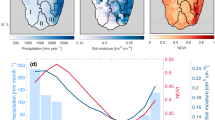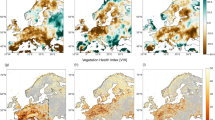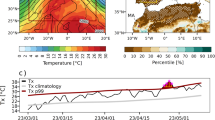Abstract
A previous reconstruction back to 800 ce indicated that the 2000–2018 soil moisture deficit in southwestern North America was exceeded during one megadrought in the late-1500s. Here, we show that after exceptional drought severity in 2021, ~19% of which is attributable to anthropogenic climate trends, 2000–2021 was the driest 22-yr period since at least 800. This drought will very likely persist through 2022, matching the duration of the late-1500s megadrought.
This is a preview of subscription content, access via your institution
Access options
Access Nature and 54 other Nature Portfolio journals
Get Nature+, our best-value online-access subscription
$29.99 / 30 days
cancel any time
Subscribe to this journal
Receive 12 print issues and online access
$209.00 per year
only $17.42 per issue
Buy this article
- Purchase on Springer Link
- Instant access to full article PDF
Prices may be subject to local taxes which are calculated during checkout


Similar content being viewed by others
Data availability
The datasets used by and produced for this study are available at at https://doi.org/10.25921/8pt9-hz08.
Code availability
The code for the analysis in this paper is available on request to the corresponding author.
References
Mankin, J. S. et al. NOAA Drought Task Force Report on the 2020–2021 Southwestern U.S. Drought (NOAA Drought Task Force, MAPP and NIDIS, 2021); https://www.drought.gov/sites/default/files/2021-09/NOAA-Drought-Task-Force-IV-Southwest-Drought-Report-9-23-21.pdf
H.R.2030—Colorado River Drought Contingency Plan Authorization Act (US House of Representatives, 2019); https://www.congress.gov/bill/116th-congress/house-bill/2030
Svoboda, M. et al. The Drought Monitor. Bull. Am. Meteorol. Soc. 83, 1181–1190 (2002).
Cook, E. R. et al. Megadroughts in North America: placing IPCC projections of hydroclimatic change in a long-term palaeoclimate context. J. Quat. Sci. 25, 48–61 (2010).
Williams, A. P. et al. Large contribution from anthropogenic warming to a developing North American megadrought. Science 368, 314–318 (2020).
Cook, B. I. et al. North American megadroughts in the Common Era: reconstructions and simulations. WIREs Clim. Change 7, 411–432 (2016).
Woodhouse, C. A. & Overpeck, J. T. 2000 years of drought variability in the central United States. Bull. Am. Meteorol. Soc. 79, 2693–2714 (1998).
Breshears, D. D. et al. Regional vegetation die-off in response to global-change-type drought. Proc. Natl Acad. Sci. USA 102, 15144–15148 (2005).
Williams, A. P. et al. Temperature as a potent driver of regional forest drought stress and tree mortality. Nat. Clim. Change 3, 292–297 (2013).
Eyring, V. et al. Overview of the Coupled Model Intercomparison Project Phase 6 (CMIP6) experimental design and organization. Geosci. Model Dev. 9, 1937–1958 (2016).
Barnett, T. P., Adam, J. C. & Lettenmaier, D. P. Potential impacts of a warming climate on water availability in snow-dominated regions. Nature 438, 303–309 (2005).
Das, T., Pierce, D. W., Cayan, D. R., Vano, J. A. & Lettenmaier, D. P. The importance of warm season warming to western US streamflow changes. Geophys. Res. Lett. 38, L23403 (2011).
Milly, P. C. D. & Dunne, K. A. Colorado River flow dwindles as warming-driven loss of reflective snow energizes evaporation. Science 367, 1252–1255 (2020).
Pascolini-Campbell, M., Reager, J. T., Chandanpurkar, H. A. & Rodell, M. A 10 per cent increase in global land evapotranspiration from 2003 to 2019. Nature 593, 543–547 (2021).
Udall, B. & Overpeck, J. The twenty‐first century Colorado River hot drought and implications for the future. Water Resour. Res. 53, 2404–2418 (2017).
Cook, B. I. et al. Uncertainties, limits, and benefits of climate change mitigation for soil moisture drought in southwestern North America. Earth’s Future 9, e2021EF002014 (2021).
Ault, T. R., Mankin, J. S., Cook, B. I. & Smerdon, J. E. Relative impacts of mitigation, temperature, and precipitation on 21st-century megadrought risk in the American Southwest. Sci. Adv. 2, e1600873 (2016).
Woodhouse, C. A., Meko, D. M., MacDonald, G. M. & Stahle, D. W. A 1,200-year perspective of 21st century drought in southwestern North America. Proc. Natl Acad. Sci. USA 107, 21283–21288 (2010).
Lepley, K. et al. A multi-century Sierra Nevada snowpack reconstruction modeled using upper-elevation coniferous tree rings (California, USA). Holocene 30, 1266–1278 (2020).
Williams, A. P. et al. Tree rings and observations suggest no stable cycles in Sierra Nevada cool-season precipitation. Water Resour. Res. 57, e2020WR028599 (2021).
Acknowledgements
We acknowledge funding from NSF AGS-1703029 (A.P.W.), AGS-1805490 (J.E.S.) and AGS-2101214 (J.E.S.); NOAA MAPP NA19OAR4310278 (A.P.W. and B.I.C.) and NA20OAR4310425 (J.E.S.); and DOE DESC0022302 (A.P.W., B.I.C. and J.E.S.). This work is possible due to many contributors of tree-ring data, largely through the International Tree-Ring Databank. Thanks also to J. Littell, who shared raw ring-width measurements that he produced from 18 sites in Idaho, Oregon and Washington.
Author information
Authors and Affiliations
Contributions
A.P.W., B.I.C. and J.E.S. conceived of the study. A.P.W. performed the primary analysis and wrote the paper. All authors helped revise the original draft manuscript.
Corresponding author
Ethics declarations
Competing interests
The authors declare no competing interests.
Peer review
Peer review information
Nature Climate Change thanks Isla Simpson, Brad Udall and the other, anonymous, reviewer(s) for their contribution to the peer review of this work.
Additional information
Publisher’s note Springer Nature remains neutral with regard to jurisdictional claims in published maps and institutional affiliations.
Extended data
Extended Data Fig. 1 Observed climate anomalies.
Anomalies in water-year (WY: October–September) (a) precipitation total, (b) temperature, and (c) vapour-pressure deficit (VPD). Maps on left show the average WY anomaly during 2000–2021. Yellow box: Southwestern North America (SWNA) study region. Anomalies are relative to 1950–1999. Time series on right show regionally averaged WY anomalies in SWNA (black) annually and as (red) 22-year running means visualized on the final year in each 22-year period. Geographic boundaries in maps were accessed through Matlab 2020a.
Extended Data Fig. 2 River flow from the upper basin of the Colorado River.
Water-year naturalized flow of the Colorado River at Lees Ferry. Data come from https://www.usbr.gov/lc/region/g4000/NaturalFlow/provisional.html as of January 27, 2022.
Extended Data Fig. 3 Seasonal climate in 2020–2021.
Seasonal rankings of precipitation (P) deficit (negative precipitation total) and vapour-pressure deficit (VPD) during June–August (JJA) 2020, September–November (SON) 2020, December–February (DJF) 2020–2021, March–May 2021, and June–August (JJA) 2021. Rankings are calculated over the 120-year period from 1902–2021. Geographic boundaries in maps were accessed through Matlab 2020a.
Extended Data Fig. 4 Extreme and exceptional drought in the western United States (US).
Weekly percentage of western continental United States (west of 103°W) classified by the United States Drought Monitor (USDM) as under extreme or exceptional drought from January 1, 2000 to December 28, 2021. Calculations were made form weekly shapefiles of USDM drought classifications, available at https://droughtmonitor.unl.edu/DmData/GISData.aspx as of January 9, 2022. The USDM is developed by the National Drought Mitigation Center (NDMC), the U.S. Department of Agriculture (USDA) and the National Oceanic and Atmospheric Administration (NOAA).
Extended Data Fig. 5 Turn-of-the-21st-century drought in the western United States and northern Mexico.
Ranking and time evolution of summer (June–August) drought severity as indicated by negative 0–200 cm soil moisture anomalies. Maps show how gridded summer drought severity in each year from 2000–2021 ranked among all years 1901–2021, where low (brown) means low soil moisture and therefore high drought severity. Yellow boxes bound the southwestern North America (SWNA) study region. Time series shows standardized anomalies (σ) of the SWNA regionally averaged soil moisture record relative to a 1950–1999 baseline. Black time series shows annual values and the red time series shows the 22-year running mean, with values displayed on the final year of each 22-year window. Geographic boundaries in maps were accessed through Matlab 2020a.
Extended Data Fig. 6 Soil-moisture reconstruction skill.
Cross-validated reconstruction skill using (a) all tree-ring chronologies that cover 1700–1983 and (b) only the subset of chronologies that cover 800–1983 to reconstruct southwestern North America (SWNA) regionally averaged summer soil moisture anomalies (black: cross-validated reconstruction, red: observed, grey shading: 95% confidence intervals). Cross-validated time series represent out-of-sample estimates made by repeatedly recalibrating the reconstruction algorithm while withholding a decade of data at a time from the calibration period (1901–1983) and making reconstruction estimates for each withheld decade (the final period withheld was longer than a decade: 1971–1983). In (a and b), soil moisture anomalies are standardized relative to 1921–2000. (c) Comparison of the 22-year running means of the SWNA regionally averaged soil moisture reconstructions produced for (red) this study versus (blue) Williams et al.5. In (c), records are standardized relative to (blue) 800–2021 and (red) 800–2018. Dashed red and blue horizontal lines represent each reconstruction’s most negative 22-year mean anomaly, which in both reconstructions occurred in 1571–1592. R2 values in c indicate the squared correlation between the two reconstructions during 800–1983 at the annual and 22-year running mean timescales.
Extended Data Fig. 7 Drought duration and extent.
(a) Number of years in a running 22-year window when the 22-year mean summer soil moisture anomaly across southwestern North America (SWNA) was drier than the 800–2021 average. (b) The percentage of SWNA area where the 22-mean summer soil moisture was locally ranked in the top 5 driest 22-year periods in 800–2021.
Extended Data Fig. 8 Drought attribution.
(a) Standardized anomalies (σ) of southwestern North American (SWNA) summer soil moisture calculated from (black) observed climate data and (turquoise) counterfactual climate data in which CMIP6 multimodel mean anthropogenic climate change (ACC) trends in temperature, relative humidity, and precipitation have been removed. (b) Same as (a) but the bold blue line shows the contribution of ACC, which is the bold black time series minus the bold turquoise time series in (a). Thin grey lines show results when the analysis is repeated removing climate trends simulated by each of the 29 CMIP6 individually (dotted blue lines show the interquartile values among the 29 grey time series). All standardization is relative to 800–2021, in which reconstructed values are used for 800–1900 and observation-based values are used for 1901–2021. Twenty-two year running means in (a) are displayed on the final year of each 22-year window.
Extended Data Fig. 9 Extended drought events.
Summer soil moisture anomalies, expressed as standard deviations from the 800–2021 mean (σ), during the longest 8 extended drought events during the 800–2021 study period. The pink background bounds the years of each extended drought event. The horizontal dotted black line represents the 800–2021 mean. For the first 7 droughts shown, soil moisture anomalies come from our tree-ring reconstruction. For the final drought (2000–2021), anomalies come from our observation-based record.
Extended Data Fig. 10 Future drought trajectories.
Simulated future trajectories of the turn-of-the-21st-century drought by extending the observed 2000–2021 record of southwestern North American soil moisture anomalies for 40 additional years (2022–2061) with each of the 1,183 40-year sequences from 800–2021. In both cases, when 2022–2061 soil moistures were replaced with 40-year soil moisture samples from within the observed period (1901–2021), we used soil moistures calculated after the removal of CMIP6 anthropogenic climate change (ACC) trends. In (a), 2022–2061 soil moisture anomalies were artificially dried by the 5-year mean ACC effect during 2017–2021 (−0.46 σ), representing a world in which the future drying effect from ACC is held at its 2017–2021 mean. In (b), no such adjustment to represent ACC drying is made, representing a future in which ACC has no effect. In both panels, the axis on the left corresponds to the red observed time series of cumulative soil moisture anomaly as well as the gridded percentages of the 1,183 simulations that result in a given cumulative soil moisture anomaly in a given year. The axis on the right corresponds to the black-and-white time series of the probability that the turn-of-the-21st-century drought survives to each year from 1 to 62. The vertical black dotted line identifies year 23, the duration of the shortest of the reconstructed megadroughts, and the horizontal black dotted line indicates the probability (P(drought)) that the turn-of-the-21st-century drought continues through a 23rd year. Determination of drought termination is made following the methods described in the Methods section.
Supplementary information
Supplementary Information
Supplementary text and Table 1.
Rights and permissions
About this article
Cite this article
Williams, A.P., Cook, B.I. & Smerdon, J.E. Rapid intensification of the emerging southwestern North American megadrought in 2020–2021. Nat. Clim. Chang. 12, 232–234 (2022). https://doi.org/10.1038/s41558-022-01290-z
Received:
Accepted:
Published:
Issue Date:
DOI: https://doi.org/10.1038/s41558-022-01290-z
This article is cited by
-
Indirect impacts of a highway on movement behavioral states of a threatened tortoise and implications for landscape connectivity
Scientific Reports (2024)
-
Dominant role of soil moisture in mediating carbon and water fluxes in dryland ecosystems
Nature Geoscience (2024)
-
Evidence of human influence on Northern Hemisphere snow loss
Nature (2024)
-
Air Pollution Interactions with Weather and Climate Extremes: Current Knowledge, Gaps, and Future Directions
Current Pollution Reports (2024)
-
Conservation implications of somatic growth and length-at-age in Pseudemys gorzugi, Rio Grande Cooter
Hydrobiologia (2024)



